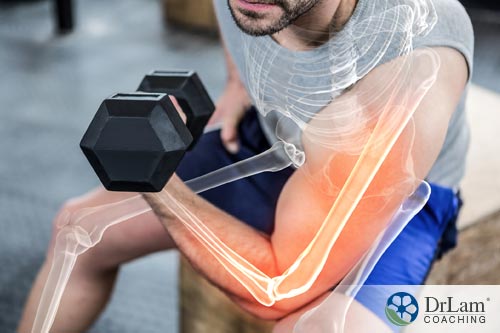Weight management is on the minds of many people in this day and age. In a technologically advanced society, where computers and machines do much of the work for us, weight gain and obesity are on the rise as a sedentary lifestyle increases. Fortunately researchers are always making new discoveries into the process the body utilizes in order to maintain weight. One recent study sheds light on the novel idea that osteocytes, a type of bone cell, may be responsible for helping your body to maintain weight.
A recent study suggests that these cells may be responsible, at least partially, for the body’s regulation of weight. Let’s take a look at this discovery and consider the implications this may have for you. We will also look into the effects of a sedentary lifestyle on weight, and the impact this has on the six circuits of the NeuroEndoMetabolic (NEM) Stress Response.
 Apart from being a bone cell, long-standing evidence suggests that these cells can also recognize when outside influences are affecting the bone. When the bone is affected, these cells will send biochemical signals, which then prompt the creation of new bone in that area. These functions occur when considerable changes in weight or pressure occur.
Apart from being a bone cell, long-standing evidence suggests that these cells can also recognize when outside influences are affecting the bone. When the bone is affected, these cells will send biochemical signals, which then prompt the creation of new bone in that area. These functions occur when considerable changes in weight or pressure occur.
Though these cells are not well understood as of yet, they may have another important function as well, according to a new study. We will take a look at that in a moment.
There is no question whether or not our bodies maintain weight, but how this occurs is only partially understood. As the body becomes conditioned to being at a particular weight, it will do its best to maintain that “normal weight.” To a large part, this is a caused by your body’s natural tendency to create equilibriums. These, among other things, prompt your body to regain any lost weight and possibly lose weight that you gain.
However, in order to achieve this stability, your body must be able to sense any changes in weight which occur. In order to make adjustments, it must then be able to monitor gradual changes in weight. Finally, it must have a network of chemical signals in place to respond to these changes. This system is like an internal weight scale. How exactly this system works is not yet clear, but here are some factors that we do know.
Equilibriums can be seen throughout the NEM system. Nearly every system in the body strives for one equilibrium or another. These “normal” ranges of each circuit of the NEM require tools, such as hormones or cells, to understand changes to each of the circuits. As for the regulation of weight, there appear to be two independent systems involved. One of these more well-known systems is a leptin-based network.
This mechanism involves a hormone which is released by fat cells, called leptin. In very basic terms, when you eat fatty foods, your body will produce leptin. This production then triggers processes which are carried out by the brain. Your brain will reduce your appetite and possibly stimulate other hormones and enzymes to deal with these changes.
This process should theoretically cause your body to drop any new weight which has been added. Obviously this system has some flaws. Otherwise, we wouldn’t gain weight. What a shame, right?
But here’s the thing: science has long suspected a second factor which is responding to the body’s changes in weight.
 This may come as a surprise, but the answer lies in your bones. Osteocytes may help give your skeleton the ability to keep weight under control. It has long been known that your bones can sense changes, or bone stresses, that are caused by shifts in weight. However, it was only recently discovered that these same processes may actually be responsible for helping your body maintain weight as well.
This may come as a surprise, but the answer lies in your bones. Osteocytes may help give your skeleton the ability to keep weight under control. It has long been known that your bones can sense changes, or bone stresses, that are caused by shifts in weight. However, it was only recently discovered that these same processes may actually be responsible for helping your body maintain weight as well.
This study brings to light new information that your bones may be much more closely involved with managing weight than was previously imagined. These cells may be responsible for appetite control, which is at least one of the methods they appear to use in order to help regulate your weight.
This process occurs mainly during strenuous exercise, while lifting heavy weights, or any other action with a high impact on the skeletal system. Sensing the change, the bones will call for extra bone cells in order to help handle the increased pressure.
The study also raises several interesting questions about the effects of a sedentary lifestyle. Perhaps this lifestyle could cause you to add extra pounds, in part by throwing sensitive systems off track. More on that later. For now, let’s check out the study.
This innovative study was published in the Proceedings of the National Academy of Sciences. It was carried out by an international group of researchers, who became interested in the body's weight maintenance cycles. Like all of the circuits in the NEM network, the maintenance of weight is run on a circuit, or cycle.
In short, this study was inspired by the rise in sedentary lifestyles. This type of lifestyle, of course, can cause a higher risk of obesity, as well as a myriad of complications in most circuits of the NEM.
The researchers based this study on the hypothesis that there must be a method by which the body regulates weight, beyond the leptin-based regulation. As a result of this study, they indeed identified a compound that operates separately from the fat-derived leptin. By now, you probably know that this compound is osteocyte.
To test their hypothesis, weight capsules were implanted on the backs or abdomens of mice. These weights were then left in place to see if the body would detect the “weight gain,” and in turn begin the necessary processes to lose the extra ounces.
It worked. Within only two days, the weighted animals were eating less. By the end of two weeks, they had nearly lost all of the weight which was added by the capsules.
When they removed the capsules from several of the mice, the weight came back.
In order to see whether the decrease in appetite was caused by an inner cycle, or by the simple fact that the mice had weight capsules implanted in their abdomens, more research was needed.
 The test was repeated in mice bred to produce low levels of leptin. In this way the researchers could be certain that it was not the leptin alone that sensed the changes in weight. The test results were again very similar, so they turned to the bones.
The test was repeated in mice bred to produce low levels of leptin. In this way the researchers could be certain that it was not the leptin alone that sensed the changes in weight. The test results were again very similar, so they turned to the bones.
In the final test, the researchers measured the role of bones in weight maintenance. The reasoning behind this came from their knowledge that skeletons are constantly sensing stress caused by shifts in weight, and therefore must have some means of sensing and possibly regulating weight.
As with the previous test in which the mice had lower levels of leptin, they bred mice that produced lower levels of osteocyte. The researchers implanted the weights in the mice, and waited for the results.
They found that mice with depleted levels of osteocytes also lost their ability to maintain weight. These animals remained artificially overweight. Their bodies had become unable to recognize the shift in weight that occured when the capsules were added. As such, their appetites were not diminished, and the weight did not “fall off” as with the previous two groups. This led the researchers to suspect that osteocytes do indeed play a major role in weight regulation.
This study proposes the idea that, as well as detecting strain on bones, these bone cells may also regulate weight in the body. This system would operate separately from the leptin-based system.
The research further proposes that the systems found in mice are also present in all mammals, including humans.
John-Olov Jansson, a neuroscientist, was one of the leads of the study. Jansson and his colleagues refer to this function of an osteocyte as a “gravitostat.” The gravitostat is triggered by the body’s weight on the bones, which is imposed by the pressures of gravity. They suspect a similar graviostat occurs in humans.
 This study may explain one of the reasons why weight gain and obesity are so prevalent in those who live a sedentary lifestyle. Though it is purely speculation at this time, the implications of osteocytes, as laid out in this study, could explain why sitting too often or sleeping too much causes significant weight gain, apart from caloric intake and other factors. This could lead to some interesting possibilities.
This study may explain one of the reasons why weight gain and obesity are so prevalent in those who live a sedentary lifestyle. Though it is purely speculation at this time, the implications of osteocytes, as laid out in this study, could explain why sitting too often or sleeping too much causes significant weight gain, apart from caloric intake and other factors. This could lead to some interesting possibilities.
Like all aspects of the NEM, your body’s ability to maintain weight comes from a very, very long history of a much more active lifestyle than we live today. Like our diets, technology has also had a great impact on our physical health.
It would make sense if the bones in your legs and feet are the primary sensors of your body’s overall weight. They are responsible for carrying most of it, after all. A shift in the distribution of your body’s weight may tip the scale unjustly.
Sitting causes the largest proportion of weight to collect on the hips and spine, instead of the legs and feet. Your body, being used to regulating weight from the feet up, may not recognize weight properly if the osteocytes are not signalling from the legs as much as they normally would have. This could possibly mean that your body thinks it weighs less than it actually does, and so your appetite is not properly diminished by your graviostats. As a result, pound after pound can sneak onto your body, without being noticed by these sensors.
This could mean that there may be another under-appreciated way to maintain a healthy weight, apart from calorie restrictions. Simply standing and walking more often could reduce your appetite, as it will trigger your graviostat systems more frequently. This could give your body a more accurate measurement as to how much gravity it is facing on a daily basis, and it may respond accordingly.
The NEM Stress Response is a lens for viewing the various circuits of your body. Through this network of circuits, we can see much more than meets the eye. Each circuit of the NEM works in unison with the others.
There are six circuits which comprise the NEM network. These are the neuroaffect, cardionomic, inflammation, metabolic, detoxification, and hormonal circuits. Each of these six circuits combine to perform the necessary functions to keep your body healthy.
It comes as no surprise that the sedentary lifestyle has many impacts on the NEM. Many health conditions which occur today are a result of this lifestyle. Realistically speaking, there is scarcely one aspect of the NEM which is not impacted in the long term by a sedentary life.
 We all know that a sedentary lifestyle makes for poor health. We should each work hard to adjust our daily habits in such a way that we get more movement in our life. This new research into osteocytes is just one of the many possible far-reaching consequences of the sedentary lifestyle.
We all know that a sedentary lifestyle makes for poor health. We should each work hard to adjust our daily habits in such a way that we get more movement in our life. This new research into osteocytes is just one of the many possible far-reaching consequences of the sedentary lifestyle.
If you work a desk job, like many of us do, make it a point to walk more, or get a standing desk. There are also many office exercises you can do from your desk, just to keep the blood moving.
No matter what you do for a living, you should keep in mind that simply standing a bit more may actually be a key to losing weight. If you are looking to maintain a healthy weight, and most of us are, it is nice to know that simply standing and walking can be a useful tool in that process. It’s not all about intense exercise and difficult diets. Maintaining weight can at times be surprisingly simple.
Osteocytes have been busy for millions of years, communicating with our bodies nonstop, and helping us to maintain a healthy skeletal structure. But recent evidence suggests that they may also perform very important functions associated with managing weight as well.
